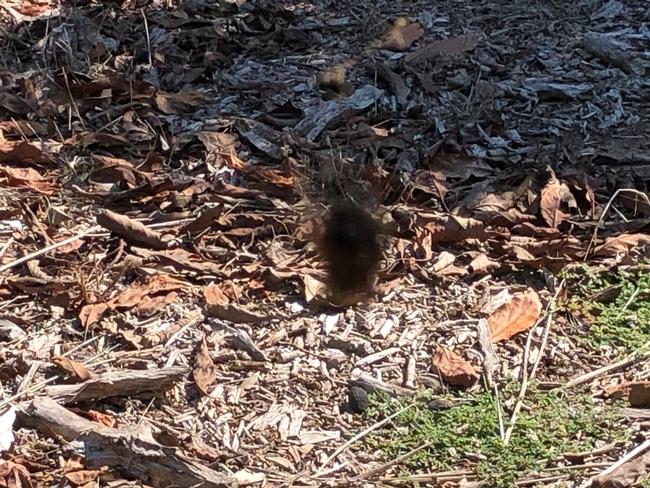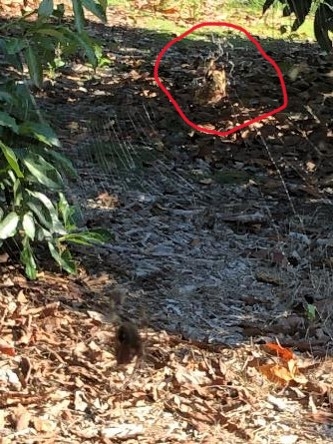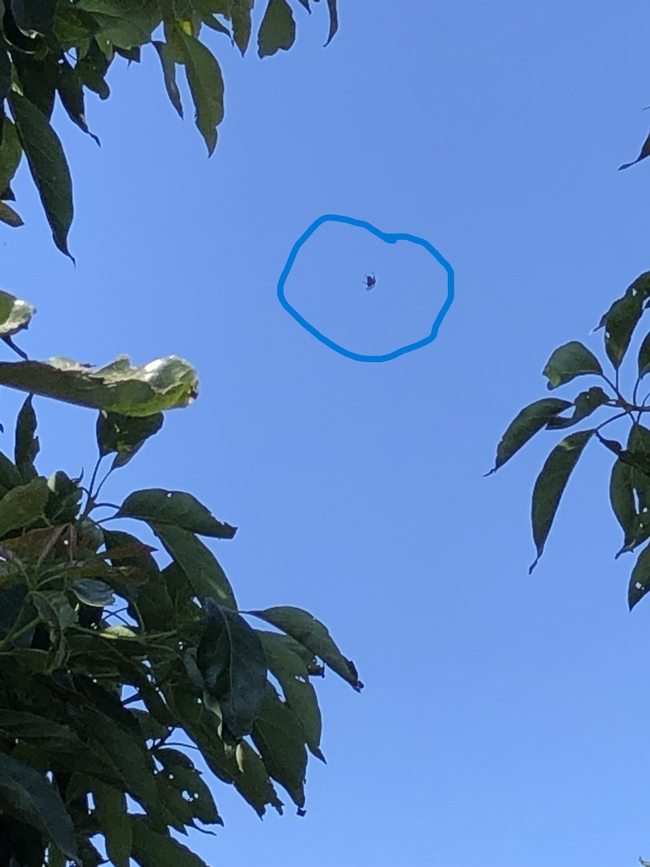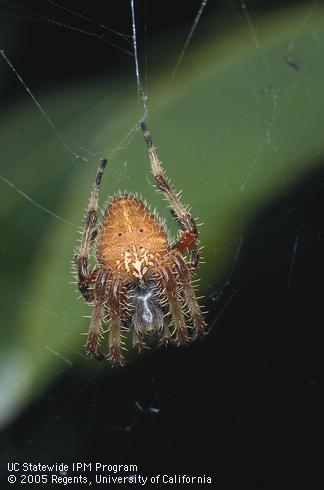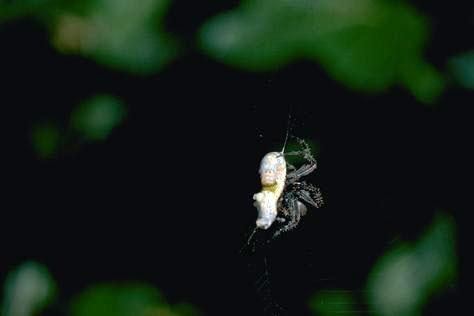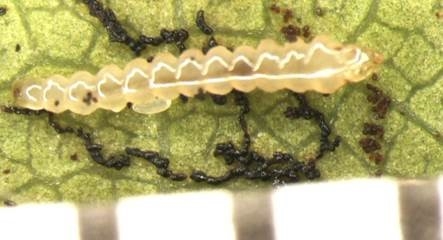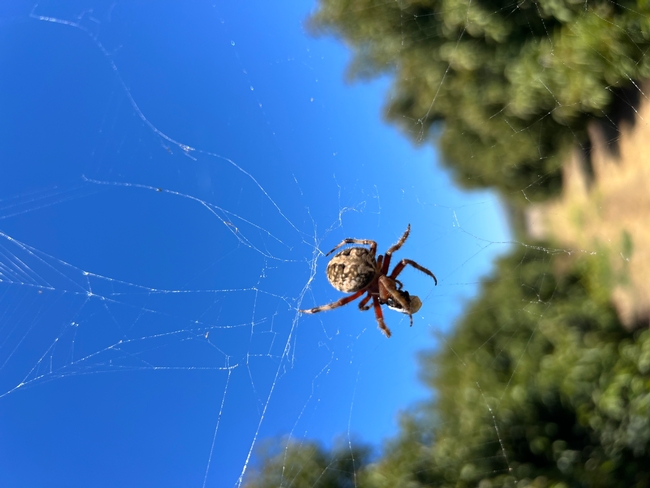Posts Tagged: worms
A Spider Year
Cruising the avocado orchard, checking out the irrigation system
Then Bang!!!!!!! What hit me?????
A little closer look, after clearing some sticky stuff off my head and hair and face and shirt and still not getting it completely off.
And there's the remainder of a spider web with a spider in the center of it (that brown blob near the top right)
And high in the sky there's another spider above my head (that little little dot)
I must have initially hit “signal threads” which alert the spider that I was coming, because just as I took these photos, it had scampered off into hiding in a leaf. I tried to get more close-ups but the spider just did not want to get close. It looked like the an unidentified species of Araneidae family of orb weaver spiders that is common in the Ventura/Santa Barbara area.
They have been common all spring and summer this year. The Year of the Orb Spider, maybe. It's been an unusual year with all the rain and mild weather. They feed on all manner of insects that fly into their webbing – thrips, whiteflies, moths, even hummingbirds have been known to be caught up in orb weaver webbing.
They are usually most active at night and morning, repairing the webbing from the night's catches and other orchard intruders. Their webbing can stretch for several feet between branches, with the web catching portion (where the circular part is most intensive) from 6 – 18 inches.
This year has also seen a flurry of infestation by the Caloptilia avocado leaf roller/miner. Maybe that's why there's been so much more spiders, since there's more food.
https://ucanr.edu/blogs/blogcore/postdetail.cfm?postnum=48887
Whatever the cause of the increased orb spiders is, it's best to thread your way through the orchard with an outstretched branch, used like the wand of a conductor, acting like you know what you are doing.
A study about orb spiders from 1980 in San Diego is available online:
California Avocado Society 1980 Yearbook 64: 153-186 A Study of Neoscona oaxacensis (Araneae: araneidae) in Commercial Avocado Orchards in San Diego County, California Frank Henry Pascoe Candidate for degree of Master of Science in Biology, San Diego State University, San Diego, California.
https://www.avocadosource.com/cas_yearbooks/cas_64_1980/cas_1980_pg_153-186.pdf
Image: Lea Boyd, Saticoy, CA 2023
Climate-Change Resources
University of California UC ANR Green Blog (Climate Change and Other Topics) https://ucanr.edu/blogs/Green/index.cfm?tagname=climate%20change (full index)
Examples:
- Save Trees First: Tips to Keep Them Alive Under Drought https://ucanr.edu/b/~CdD
- Landscaping with Fire Exposure in Mind: https://ucanr.edu/b/~G4D
- Cities in California Inland Areas Must Make Street Tree Changes to adapt to Future Climate https://ucanr.edu/b/~oF7
Drought, Climate Change and California Water Management Ted Grantham, UC Cooperative Extension specialist (23 minutes) https://youtu.be/dlimj75Wn9Q
Climate Variability and Change: Trends and Impacts on CA Agriculture Tapan Pathak, UC Cooperative Extension specialist (24 minutes) https://youtu.be/bIHI0yqqQJc
California Institute for Water Resources (links to blogs, talks, podcasts, water experts, etc.) https://ciwr.ucanr.edu/California_Drought_Expertise/
UC ANR Wildfire Resources (publications, videos, etc.) https://ucanr.edu/News/For_the_media/Press_kits/Wildfire/ (main website)
-UC ANR Fire Resources and Information https://ucanr.edu/sites/fire/ (main website)
-Preparing Home Landscaping https://ucanr.edu/sites/fire/Prepare/Landscaping/
UC ANR Free Publications https://anrcatalog.ucanr.edu/ (main website)
- Benefits of Plants to Humans and Urban Ecosystems: https://anrcatalog.ucanr.edu/pdf/8726.pdf
-Keeping Plants Alive Under Drought and Water Restrictions (English version) https://anrcatalog.ucanr.edu/pdf/8553.pdf
(Spanish version) https://anrcatalog.ucanr.edu/pdf/8628.pdf
- Use of Graywater in Urban Landscapes https://anrcatalog.ucanr.edu/pdf/8536.pdf
- Sustainable Landscaping in California https://anrcatalog.ucanr.edu/pdf/8504.pdf
Other (Non-UC) Climate Change Resources
Urban Forests and Climate Change. Urban forests play an important role in climate change mitigation and adaptation. Active stewardship of a community's forestry assets can strengthen local resilience to climate change while creating more sustainable and desirable places to live. https://www.fs.usda.gov/ccrc/topics/urban-forests
Examining the Viability of Planting Trees to Mitigate Climate Change (plausible at the forest level) https://climate.nasa.gov/news/2927/examining-the-viability-of-planting-trees-to-help-mitigate-climate-change/
Reports and other information resources coordinated under the auspices of the United Nations and produced through the collaboration of thousands of international scientists to provide a clear and up to date view of the current state of scientific knowledge relevant to climate change. United Nations Climate Action
Scientific reports, programs, action movements and events related to climate change. National Center for Atmospheric Research (National Science Foundation)
Find useful reports, program information and other documents resulting from federally funded research and development into the behavior of the atmosphere and related physical, biological and social systems. Search and find climate data from prehistory through to an hour ago in the world's largest climate data archive. (Formerly the "Climatic Data Center") National Centers for Environmental Information (NOAA)
Think tank providing information, analysis, policy and solution development for addressing climate change and energy issues (formerly known as the: "Pew Center on Global Climate Change"). Center for Climate & Energy Solutions (C2ES)
Mapping Resilience: A Blueprint for Thriving in the Face of Climate Disaster. The Climate Adaptation Knowledge Exchange (CAKE) was launched in July 2010 and is managed by EcoAdapt, a non-profit with a singular mission: to create a robust future in the face of climate change by bringing together diverse players to reshape planning and management in response to rapid climate change. https://www.cakex.org/documents/mapping-resilience-blueprint-thriving-face-climate-disaster
Cal-Adapt provides a way to explore peer-reviewed data that portrays how climate change might affect California at the state and local level. We make this data available through downloads, visualizations, and the Cal-Adapt API for your research, outreach, and adaptation planning needs. Cal-Adapt is a collaboration between state agency funding programs, university and private sector researchers https://cal-adapt.org/
Find reports, maps, data and other resources produced through a confederation of the research arms of 13 Federal departments and agencies that carry out research and develop and maintain capabilities that support the Nation's response to global change. Global Change (U.S. Global Change Research Program)
The Pacific Institute is a global water think tank that combines science-based thought leadership with active outreach to influence local, national, and international efforts to develop sustainable water policies. https://pacinst.org/our-approach/
Making equity real in climate adaptation and community resilience policies and programs: a guidebook. https://greenlining.org/publications/2019/making-equity-real-in-climate-adaption-and-community-resilience-policies-and-programs-a-guidebook/
Quarterly CA Climate Updates and CA Drought Monitor Maps (updated each Thursday) https://www.drought.gov/documents/quarterly-climate-impacts-and-outlook-western-region-june-2022
Earth Worms
There are 1,800 species of earthworms grouped into five families and distributed all over the world. Some grow as long as 3 feet, while others are only a few tenths of inches. We call them nightcrawlers, field worms, manure worms, red worms and some people just say "yuck."
Numerous investigators have pointed out the beneficial effects of earthworms on soil properties. One of the first of these observers was Charles Darwin who published Earthworms and Vegetable Mould in 1881. He remarked on the great quantity of soil the worms can move in a year. He estimated that the earthworms in some of his pastures could form a new layer of soil 7 inches thick in thirty years, or that they brought up about 20 tons of soil per acre, enough to form a layer 0.2 inch deep each year.
Earthworms, where they flourish, are important agents in mixing the dead surface litter with the main body of the soil. They drag the leaves and other litter down into their burrows where soil microorganisms also begin digesting the material. Some earthworms can burrow as deeply as 5 to 6 feet, but most concentrate in the top 6 to 8 inches of soil.
The worm subsists on organic matter such as leaves and dead roots near the soil surface. The earthworm ingests soil particles along with the organic matter and grinds up the organic matter in a gizzard just as a chicken does. This is excreted in what we call worm casts. The castings differ chemically from the rest of the soil, as they are richer in nitrogen, potassium and other mineral constituents.
Castings are a natural by-product of worms. When added to normal soils in gardens or lawns, they provide the same kinds of benefits as other bulky organic fertilizers. Castings today are not commonly used as fertilizer by commercial plant growers because of their cost relative to other fertilizers. However, castings are used by some organic growers and are sold commercially as a soil amendment or planting medium for ornamental plants grown in pots.
The physical soil churning process also has several important effects:
- Organic residues are more rapidly degraded with the release of elements such as nitrogen, sulfur and other nutrients.
- Some of the inorganic soil minerals tend to be solubilized by the digestive process.
- Extensive burrowing improves soil aeration.
- Burrowing can improve water penetration into soils
- The earthworm carries surface nutrients from the soil surface and imports them into the root zone of the plant.
Although earthworms are considered beneficial to soil productivity, few valid studies have been made to determine whether their presence will significantly improve plant growth. This may seem odd since many of us have learned from childhood that worms are good. It is something like the chicken and the egg analogy. The conditions that are conducive to earthworms are also ideal for plants. Both plants and worms need temperatures between 60 and 100 degrees F for good growth; both need water, but not too much or little; they both require oxygen for respiration; and they do not like soils that are too acid or basic or too salty. By correcting soil conditions that are unfavorable for one will also improve the outlook for the other. The earthworm is a natural component of the soil population. If the soil is properly managed this natural population will thrive. In this sense, the presence or absence or earthworms can be an indicator of the "fertility" of one's soil.

earthworm
Host and a Parasite: Battle of Sand Field Crickets vs. Horsehair Worms
If you were a sand field cricket, you would not like horsehair worms. "The horsehair worm (Paragordius varius) is a long-lived parasite that infects arthropods, including the sand field cricket, Gryllus firmus," says...
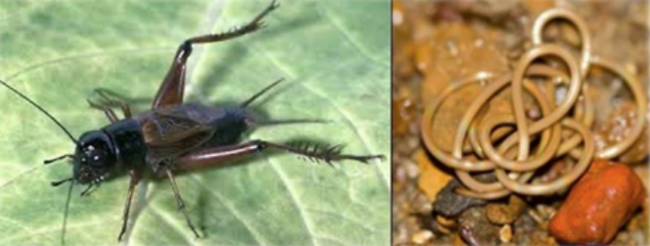
A sand field cricket (Gryllus firmus), and a horsehair worm (Paragordius varius). (Photos courtesy of Amy Worthington)
Amy Worthington: Harboring a Long-Lived Parasite
Biologist Amy Worthington, assistant professor, Creighton University, Omaha, Neb., will discuss her research, "A Host of Hardships: The Costs of Harboring a Long-Lived Parasite," at the UC Davis Department of Entomology and Nematology seminar on...

Creighton University biologist Amy Worthington will show these two illustrations at her seminar: At left is a sand field cricket, Gryllus firmus, and at right, a horsehair worm, Paragordius varius.


